World Commission on Environment and Development (WCED)
VerifiedAdded on 2021/01/27
|12
|4118
|56
AI Summary
Contribute Materials
Your contribution can guide someone’s learning journey. Share your
documents today.

Executive Summary:
This report analyses the sustainable and ethical business practices in construction industry.
The ethical business practices are evaluated by identifying the bribery and corruption
culture, whereas external auditing is recommended to improve ethical business practices.
The health and safety issues are more important for construction projects which can be
achieved by adopting ISO 45001 standards. The excessive use of resources in construction is
directly polluting the land, water, and air. The ISO 14001 standards can help construction
companies to comply with environmental friendly practices. The EMS process can also help
reducing greenhouse gas emissions, whereas lifecycle assessment of materials can help in
achieving cleaner production.
1. Introduction:
The World Commission on Environment and Development (WCED) defined ‘Sustainable
Development’ in terms of meeting the needs of present generation without affecting the
ability and needs of future generation to access resources in future. There are many
industries which are neglecting the sustainable development practices such as
manufacturing, construction, and others (Svensson and Høgevold, 2017). The construction
industry is considered as the most corruptive and dangerous industry due to involvement of
high stakes and investments. However, international agencies and bodies have introduced
different standards, regulations and policies to prevent unethical business practices in
construction industry (Alwan et al., 2017).
Due to high resource requirements for construction projects, there are high risks involved
for damaging environmental factors such as air pollution, land pollution, and water
pollution. The United Nations (UN) along with other global actors such as OECD, World Bank
emphasizes to reduce global warming and to adopt eco-friendly practices all over the world
(Farouq et al., 2017). The local government bodies play important role ensuring adoption of
environmental friendly practices by different industries. The legislation requires local
companies to comply with standards and regulations such as Companies Act 2006 UK and
ISO 14001 (Alwan et al., 2017).
This report analyses the sustainable and ethical business practices in construction industry.
The ethical business practices are evaluated by identifying the bribery and corruption
culture, whereas external auditing is recommended to improve ethical business practices.
The health and safety issues are more important for construction projects which can be
achieved by adopting ISO 45001 standards. The excessive use of resources in construction is
directly polluting the land, water, and air. The ISO 14001 standards can help construction
companies to comply with environmental friendly practices. The EMS process can also help
reducing greenhouse gas emissions, whereas lifecycle assessment of materials can help in
achieving cleaner production.
1. Introduction:
The World Commission on Environment and Development (WCED) defined ‘Sustainable
Development’ in terms of meeting the needs of present generation without affecting the
ability and needs of future generation to access resources in future. There are many
industries which are neglecting the sustainable development practices such as
manufacturing, construction, and others (Svensson and Høgevold, 2017). The construction
industry is considered as the most corruptive and dangerous industry due to involvement of
high stakes and investments. However, international agencies and bodies have introduced
different standards, regulations and policies to prevent unethical business practices in
construction industry (Alwan et al., 2017).
Due to high resource requirements for construction projects, there are high risks involved
for damaging environmental factors such as air pollution, land pollution, and water
pollution. The United Nations (UN) along with other global actors such as OECD, World Bank
emphasizes to reduce global warming and to adopt eco-friendly practices all over the world
(Farouq et al., 2017). The local government bodies play important role ensuring adoption of
environmental friendly practices by different industries. The legislation requires local
companies to comply with standards and regulations such as Companies Act 2006 UK and
ISO 14001 (Alwan et al., 2017).
Secure Best Marks with AI Grader
Need help grading? Try our AI Grader for instant feedback on your assignments.
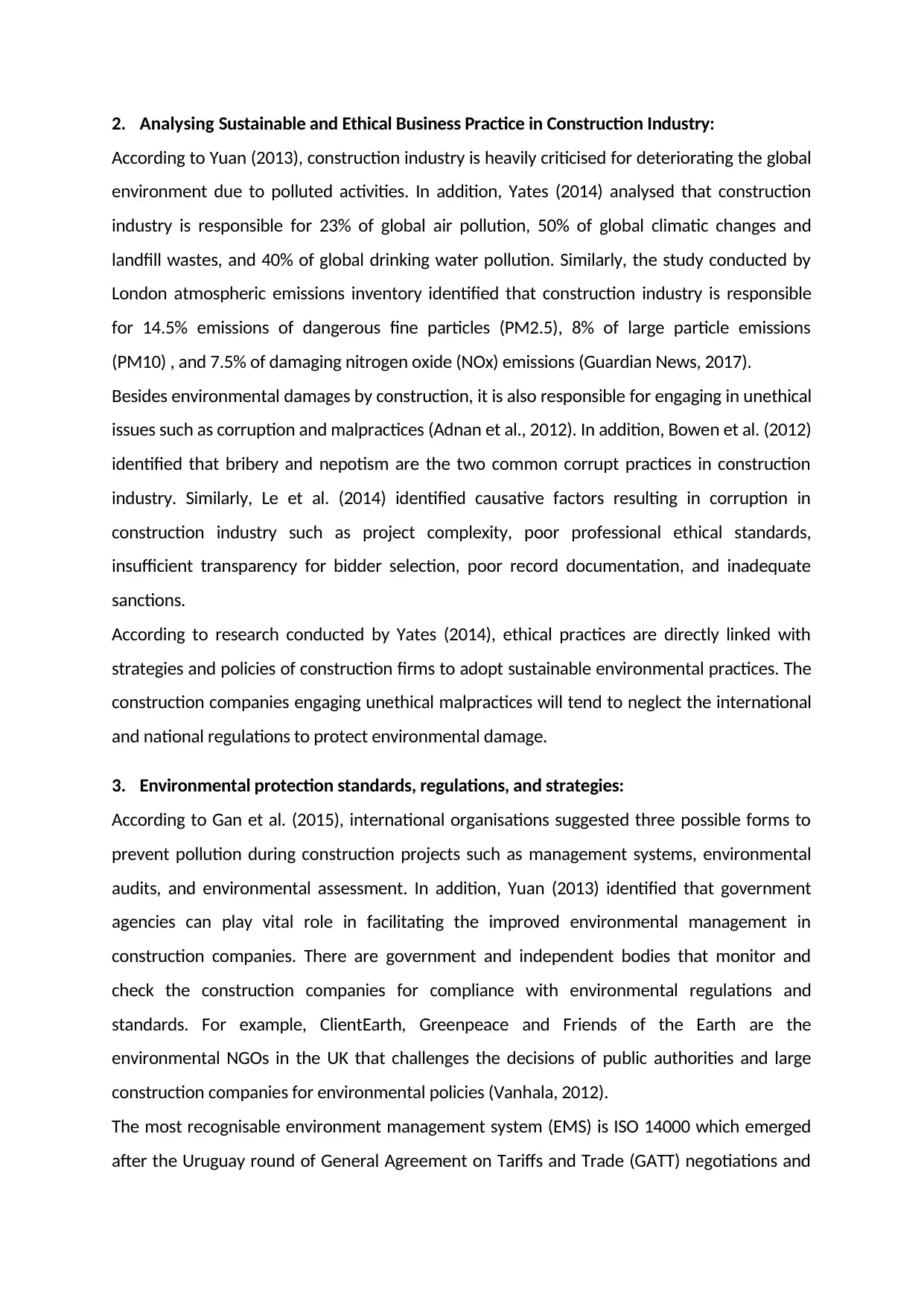
2. Analysing Sustainable and Ethical Business Practice in Construction Industry:
According to Yuan (2013), construction industry is heavily criticised for deteriorating the global
environment due to polluted activities. In addition, Yates (2014) analysed that construction
industry is responsible for 23% of global air pollution, 50% of global climatic changes and
landfill wastes, and 40% of global drinking water pollution. Similarly, the study conducted by
London atmospheric emissions inventory identified that construction industry is responsible
for 14.5% emissions of dangerous fine particles (PM2.5), 8% of large particle emissions
(PM10) , and 7.5% of damaging nitrogen oxide (NOx) emissions (Guardian News, 2017).
Besides environmental damages by construction, it is also responsible for engaging in unethical
issues such as corruption and malpractices (Adnan et al., 2012). In addition, Bowen et al. (2012)
identified that bribery and nepotism are the two common corrupt practices in construction
industry. Similarly, Le et al. (2014) identified causative factors resulting in corruption in
construction industry such as project complexity, poor professional ethical standards,
insufficient transparency for bidder selection, poor record documentation, and inadequate
sanctions.
According to research conducted by Yates (2014), ethical practices are directly linked with
strategies and policies of construction firms to adopt sustainable environmental practices. The
construction companies engaging unethical malpractices will tend to neglect the international
and national regulations to protect environmental damage.
3. Environmental protection standards, regulations, and strategies:
According to Gan et al. (2015), international organisations suggested three possible forms to
prevent pollution during construction projects such as management systems, environmental
audits, and environmental assessment. In addition, Yuan (2013) identified that government
agencies can play vital role in facilitating the improved environmental management in
construction companies. There are government and independent bodies that monitor and
check the construction companies for compliance with environmental regulations and
standards. For example, ClientEarth, Greenpeace and Friends of the Earth are the
environmental NGOs in the UK that challenges the decisions of public authorities and large
construction companies for environmental policies (Vanhala, 2012).
The most recognisable environment management system (EMS) is ISO 14000 which emerged
after the Uruguay round of General Agreement on Tariffs and Trade (GATT) negotiations and
According to Yuan (2013), construction industry is heavily criticised for deteriorating the global
environment due to polluted activities. In addition, Yates (2014) analysed that construction
industry is responsible for 23% of global air pollution, 50% of global climatic changes and
landfill wastes, and 40% of global drinking water pollution. Similarly, the study conducted by
London atmospheric emissions inventory identified that construction industry is responsible
for 14.5% emissions of dangerous fine particles (PM2.5), 8% of large particle emissions
(PM10) , and 7.5% of damaging nitrogen oxide (NOx) emissions (Guardian News, 2017).
Besides environmental damages by construction, it is also responsible for engaging in unethical
issues such as corruption and malpractices (Adnan et al., 2012). In addition, Bowen et al. (2012)
identified that bribery and nepotism are the two common corrupt practices in construction
industry. Similarly, Le et al. (2014) identified causative factors resulting in corruption in
construction industry such as project complexity, poor professional ethical standards,
insufficient transparency for bidder selection, poor record documentation, and inadequate
sanctions.
According to research conducted by Yates (2014), ethical practices are directly linked with
strategies and policies of construction firms to adopt sustainable environmental practices. The
construction companies engaging unethical malpractices will tend to neglect the international
and national regulations to protect environmental damage.
3. Environmental protection standards, regulations, and strategies:
According to Gan et al. (2015), international organisations suggested three possible forms to
prevent pollution during construction projects such as management systems, environmental
audits, and environmental assessment. In addition, Yuan (2013) identified that government
agencies can play vital role in facilitating the improved environmental management in
construction companies. There are government and independent bodies that monitor and
check the construction companies for compliance with environmental regulations and
standards. For example, ClientEarth, Greenpeace and Friends of the Earth are the
environmental NGOs in the UK that challenges the decisions of public authorities and large
construction companies for environmental policies (Vanhala, 2012).
The most recognisable environment management system (EMS) is ISO 14000 which emerged
after the Uruguay round of General Agreement on Tariffs and Trade (GATT) negotiations and
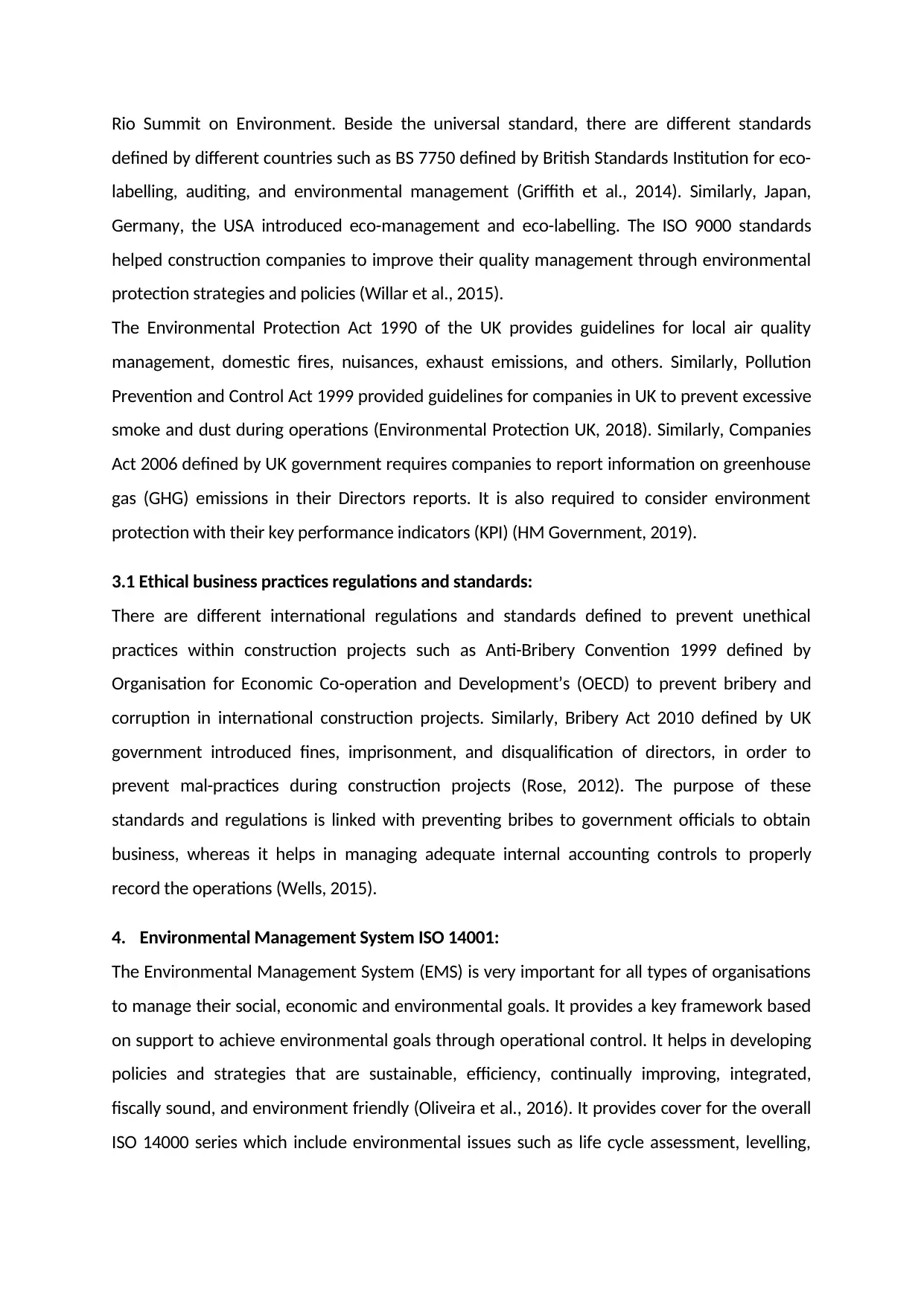
Rio Summit on Environment. Beside the universal standard, there are different standards
defined by different countries such as BS 7750 defined by British Standards Institution for eco-
labelling, auditing, and environmental management (Griffith et al., 2014). Similarly, Japan,
Germany, the USA introduced eco-management and eco-labelling. The ISO 9000 standards
helped construction companies to improve their quality management through environmental
protection strategies and policies (Willar et al., 2015).
The Environmental Protection Act 1990 of the UK provides guidelines for local air quality
management, domestic fires, nuisances, exhaust emissions, and others. Similarly, Pollution
Prevention and Control Act 1999 provided guidelines for companies in UK to prevent excessive
smoke and dust during operations (Environmental Protection UK, 2018). Similarly, Companies
Act 2006 defined by UK government requires companies to report information on greenhouse
gas (GHG) emissions in their Directors reports. It is also required to consider environment
protection with their key performance indicators (KPI) (HM Government, 2019).
3.1 Ethical business practices regulations and standards:
There are different international regulations and standards defined to prevent unethical
practices within construction projects such as Anti-Bribery Convention 1999 defined by
Organisation for Economic Co-operation and Development’s (OECD) to prevent bribery and
corruption in international construction projects. Similarly, Bribery Act 2010 defined by UK
government introduced fines, imprisonment, and disqualification of directors, in order to
prevent mal-practices during construction projects (Rose, 2012). The purpose of these
standards and regulations is linked with preventing bribes to government officials to obtain
business, whereas it helps in managing adequate internal accounting controls to properly
record the operations (Wells, 2015).
4. Environmental Management System ISO 14001:
The Environmental Management System (EMS) is very important for all types of organisations
to manage their social, economic and environmental goals. It provides a key framework based
on support to achieve environmental goals through operational control. It helps in developing
policies and strategies that are sustainable, efficiency, continually improving, integrated,
fiscally sound, and environment friendly (Oliveira et al., 2016). It provides cover for the overall
ISO 14000 series which include environmental issues such as life cycle assessment, levelling,
defined by different countries such as BS 7750 defined by British Standards Institution for eco-
labelling, auditing, and environmental management (Griffith et al., 2014). Similarly, Japan,
Germany, the USA introduced eco-management and eco-labelling. The ISO 9000 standards
helped construction companies to improve their quality management through environmental
protection strategies and policies (Willar et al., 2015).
The Environmental Protection Act 1990 of the UK provides guidelines for local air quality
management, domestic fires, nuisances, exhaust emissions, and others. Similarly, Pollution
Prevention and Control Act 1999 provided guidelines for companies in UK to prevent excessive
smoke and dust during operations (Environmental Protection UK, 2018). Similarly, Companies
Act 2006 defined by UK government requires companies to report information on greenhouse
gas (GHG) emissions in their Directors reports. It is also required to consider environment
protection with their key performance indicators (KPI) (HM Government, 2019).
3.1 Ethical business practices regulations and standards:
There are different international regulations and standards defined to prevent unethical
practices within construction projects such as Anti-Bribery Convention 1999 defined by
Organisation for Economic Co-operation and Development’s (OECD) to prevent bribery and
corruption in international construction projects. Similarly, Bribery Act 2010 defined by UK
government introduced fines, imprisonment, and disqualification of directors, in order to
prevent mal-practices during construction projects (Rose, 2012). The purpose of these
standards and regulations is linked with preventing bribes to government officials to obtain
business, whereas it helps in managing adequate internal accounting controls to properly
record the operations (Wells, 2015).
4. Environmental Management System ISO 14001:
The Environmental Management System (EMS) is very important for all types of organisations
to manage their social, economic and environmental goals. It provides a key framework based
on support to achieve environmental goals through operational control. It helps in developing
policies and strategies that are sustainable, efficiency, continually improving, integrated,
fiscally sound, and environment friendly (Oliveira et al., 2016). It provides cover for the overall
ISO 14000 series which include environmental issues such as life cycle assessment, levelling,
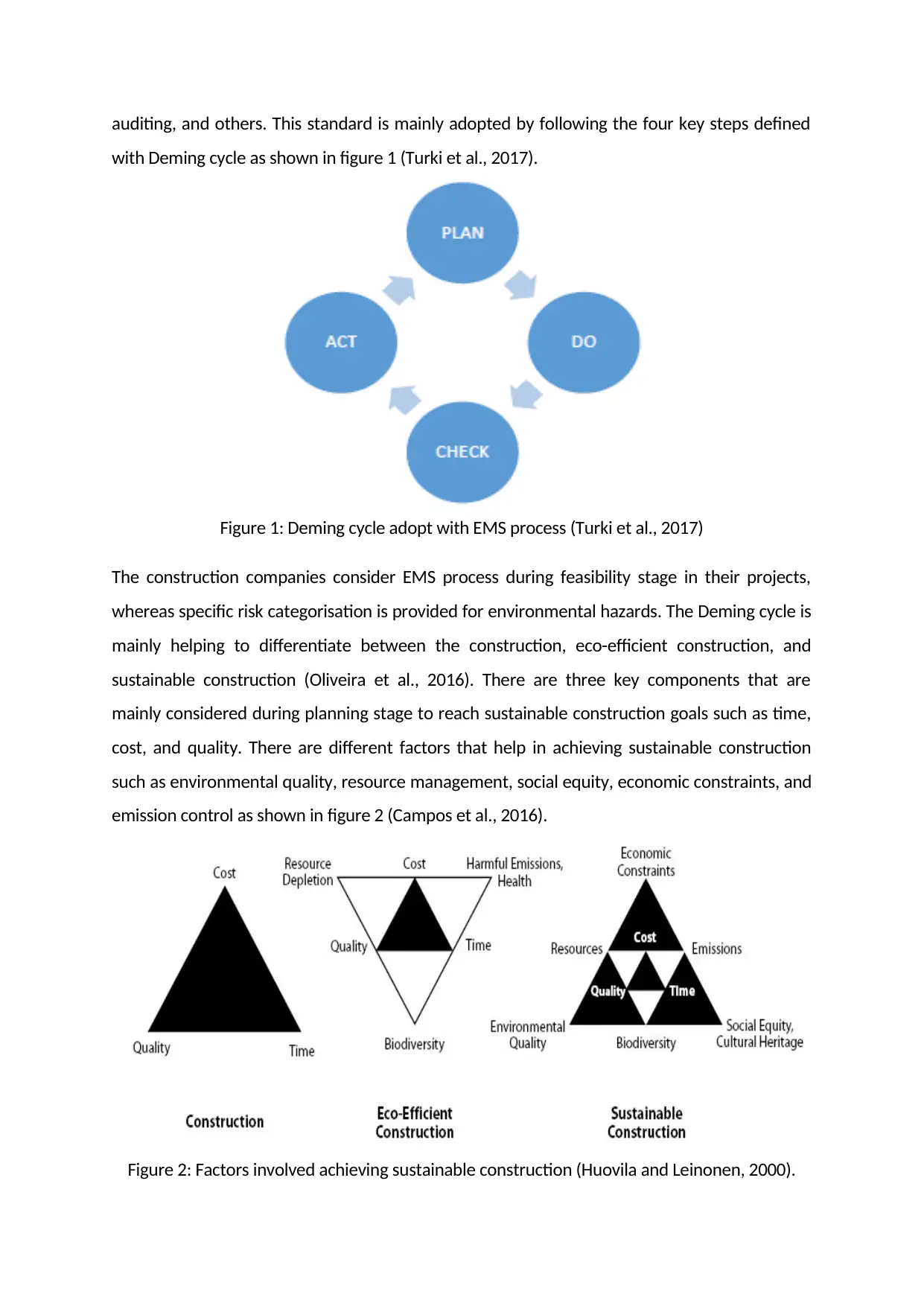
auditing, and others. This standard is mainly adopted by following the four key steps defined
with Deming cycle as shown in figure 1 (Turki et al., 2017).
Figure 1: Deming cycle adopt with EMS process (Turki et al., 2017)
The construction companies consider EMS process during feasibility stage in their projects,
whereas specific risk categorisation is provided for environmental hazards. The Deming cycle is
mainly helping to differentiate between the construction, eco-efficient construction, and
sustainable construction (Oliveira et al., 2016). There are three key components that are
mainly considered during planning stage to reach sustainable construction goals such as time,
cost, and quality. There are different factors that help in achieving sustainable construction
such as environmental quality, resource management, social equity, economic constraints, and
emission control as shown in figure 2 (Campos et al., 2016).
Figure 2: Factors involved achieving sustainable construction (Huovila and Leinonen, 2000).
with Deming cycle as shown in figure 1 (Turki et al., 2017).
Figure 1: Deming cycle adopt with EMS process (Turki et al., 2017)
The construction companies consider EMS process during feasibility stage in their projects,
whereas specific risk categorisation is provided for environmental hazards. The Deming cycle is
mainly helping to differentiate between the construction, eco-efficient construction, and
sustainable construction (Oliveira et al., 2016). There are three key components that are
mainly considered during planning stage to reach sustainable construction goals such as time,
cost, and quality. There are different factors that help in achieving sustainable construction
such as environmental quality, resource management, social equity, economic constraints, and
emission control as shown in figure 2 (Campos et al., 2016).
Figure 2: Factors involved achieving sustainable construction (Huovila and Leinonen, 2000).
Secure Best Marks with AI Grader
Need help grading? Try our AI Grader for instant feedback on your assignments.
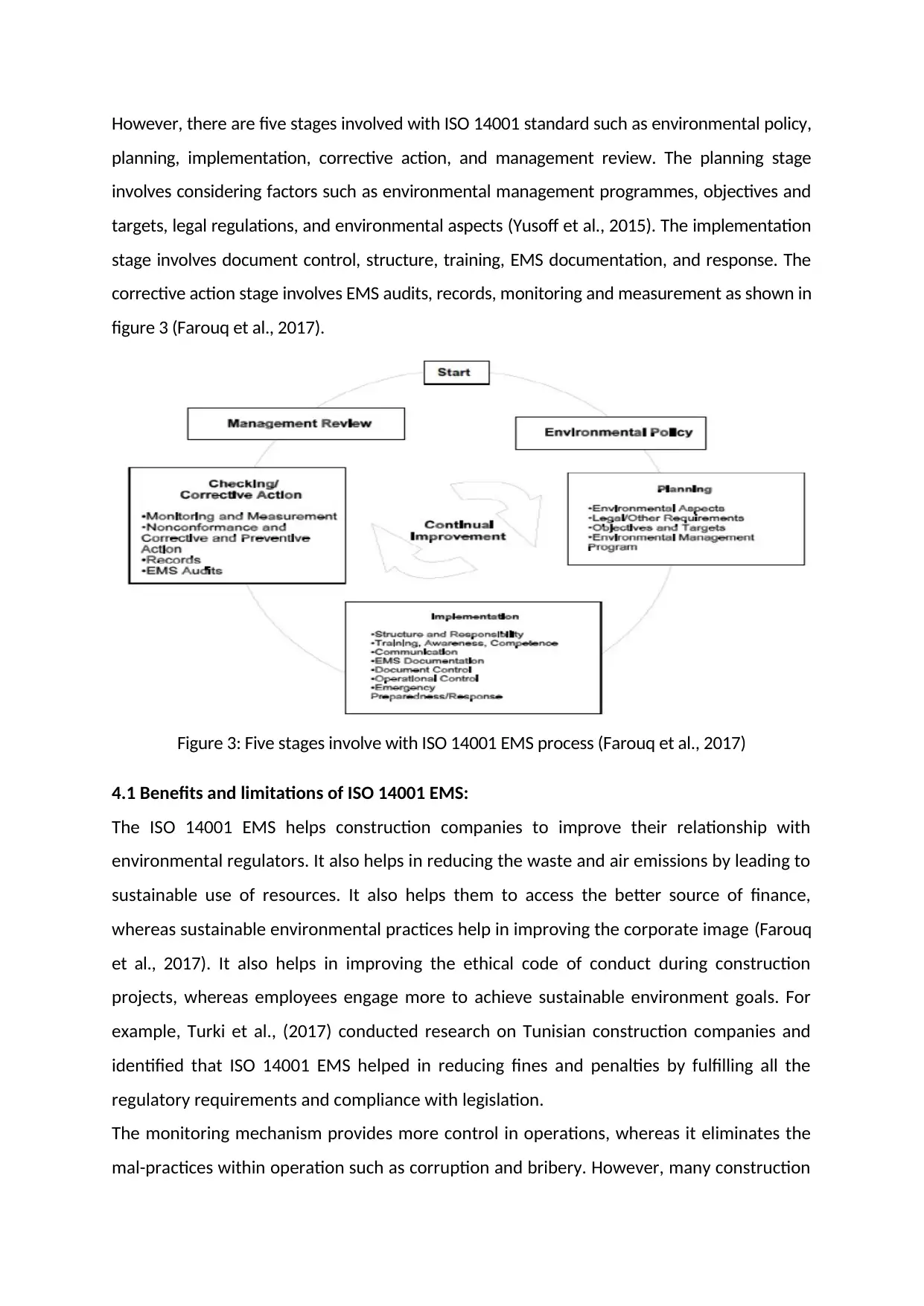
However, there are five stages involved with ISO 14001 standard such as environmental policy,
planning, implementation, corrective action, and management review. The planning stage
involves considering factors such as environmental management programmes, objectives and
targets, legal regulations, and environmental aspects (Yusoff et al., 2015). The implementation
stage involves document control, structure, training, EMS documentation, and response. The
corrective action stage involves EMS audits, records, monitoring and measurement as shown in
figure 3 (Farouq et al., 2017).
Figure 3: Five stages involve with ISO 14001 EMS process (Farouq et al., 2017)
4.1 Benefits and limitations of ISO 14001 EMS:
The ISO 14001 EMS helps construction companies to improve their relationship with
environmental regulators. It also helps in reducing the waste and air emissions by leading to
sustainable use of resources. It also helps them to access the better source of finance,
whereas sustainable environmental practices help in improving the corporate image (Farouq
et al., 2017). It also helps in improving the ethical code of conduct during construction
projects, whereas employees engage more to achieve sustainable environment goals. For
example, Turki et al., (2017) conducted research on Tunisian construction companies and
identified that ISO 14001 EMS helped in reducing fines and penalties by fulfilling all the
regulatory requirements and compliance with legislation.
The monitoring mechanism provides more control in operations, whereas it eliminates the
mal-practices within operation such as corruption and bribery. However, many construction
planning, implementation, corrective action, and management review. The planning stage
involves considering factors such as environmental management programmes, objectives and
targets, legal regulations, and environmental aspects (Yusoff et al., 2015). The implementation
stage involves document control, structure, training, EMS documentation, and response. The
corrective action stage involves EMS audits, records, monitoring and measurement as shown in
figure 3 (Farouq et al., 2017).
Figure 3: Five stages involve with ISO 14001 EMS process (Farouq et al., 2017)
4.1 Benefits and limitations of ISO 14001 EMS:
The ISO 14001 EMS helps construction companies to improve their relationship with
environmental regulators. It also helps in reducing the waste and air emissions by leading to
sustainable use of resources. It also helps them to access the better source of finance,
whereas sustainable environmental practices help in improving the corporate image (Farouq
et al., 2017). It also helps in improving the ethical code of conduct during construction
projects, whereas employees engage more to achieve sustainable environment goals. For
example, Turki et al., (2017) conducted research on Tunisian construction companies and
identified that ISO 14001 EMS helped in reducing fines and penalties by fulfilling all the
regulatory requirements and compliance with legislation.
The monitoring mechanism provides more control in operations, whereas it eliminates the
mal-practices within operation such as corruption and bribery. However, many construction
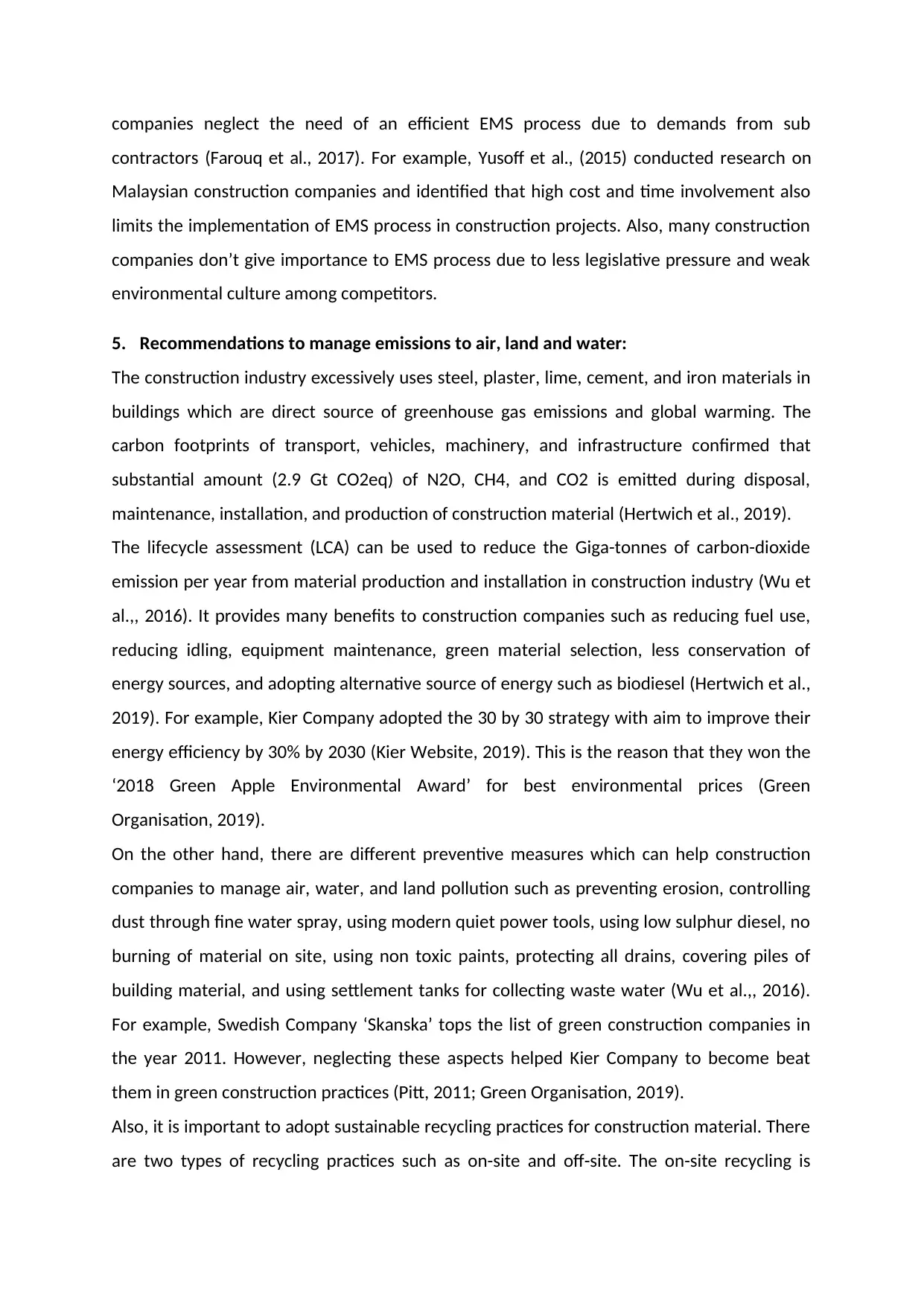
companies neglect the need of an efficient EMS process due to demands from sub
contractors (Farouq et al., 2017). For example, Yusoff et al., (2015) conducted research on
Malaysian construction companies and identified that high cost and time involvement also
limits the implementation of EMS process in construction projects. Also, many construction
companies don’t give importance to EMS process due to less legislative pressure and weak
environmental culture among competitors.
5. Recommendations to manage emissions to air, land and water:
The construction industry excessively uses steel, plaster, lime, cement, and iron materials in
buildings which are direct source of greenhouse gas emissions and global warming. The
carbon footprints of transport, vehicles, machinery, and infrastructure confirmed that
substantial amount (2.9 Gt CO2eq) of N2O, CH4, and CO2 is emitted during disposal,
maintenance, installation, and production of construction material (Hertwich et al., 2019).
The lifecycle assessment (LCA) can be used to reduce the Giga-tonnes of carbon-dioxide
emission per year from material production and installation in construction industry (Wu et
al.,, 2016). It provides many benefits to construction companies such as reducing fuel use,
reducing idling, equipment maintenance, green material selection, less conservation of
energy sources, and adopting alternative source of energy such as biodiesel (Hertwich et al.,
2019). For example, Kier Company adopted the 30 by 30 strategy with aim to improve their
energy efficiency by 30% by 2030 (Kier Website, 2019). This is the reason that they won the
‘2018 Green Apple Environmental Award’ for best environmental prices (Green
Organisation, 2019).
On the other hand, there are different preventive measures which can help construction
companies to manage air, water, and land pollution such as preventing erosion, controlling
dust through fine water spray, using modern quiet power tools, using low sulphur diesel, no
burning of material on site, using non toxic paints, protecting all drains, covering piles of
building material, and using settlement tanks for collecting waste water (Wu et al.,, 2016).
For example, Swedish Company ‘Skanska’ tops the list of green construction companies in
the year 2011. However, neglecting these aspects helped Kier Company to become beat
them in green construction practices (Pitt, 2011; Green Organisation, 2019).
Also, it is important to adopt sustainable recycling practices for construction material. There
are two types of recycling practices such as on-site and off-site. The on-site recycling is
contractors (Farouq et al., 2017). For example, Yusoff et al., (2015) conducted research on
Malaysian construction companies and identified that high cost and time involvement also
limits the implementation of EMS process in construction projects. Also, many construction
companies don’t give importance to EMS process due to less legislative pressure and weak
environmental culture among competitors.
5. Recommendations to manage emissions to air, land and water:
The construction industry excessively uses steel, plaster, lime, cement, and iron materials in
buildings which are direct source of greenhouse gas emissions and global warming. The
carbon footprints of transport, vehicles, machinery, and infrastructure confirmed that
substantial amount (2.9 Gt CO2eq) of N2O, CH4, and CO2 is emitted during disposal,
maintenance, installation, and production of construction material (Hertwich et al., 2019).
The lifecycle assessment (LCA) can be used to reduce the Giga-tonnes of carbon-dioxide
emission per year from material production and installation in construction industry (Wu et
al.,, 2016). It provides many benefits to construction companies such as reducing fuel use,
reducing idling, equipment maintenance, green material selection, less conservation of
energy sources, and adopting alternative source of energy such as biodiesel (Hertwich et al.,
2019). For example, Kier Company adopted the 30 by 30 strategy with aim to improve their
energy efficiency by 30% by 2030 (Kier Website, 2019). This is the reason that they won the
‘2018 Green Apple Environmental Award’ for best environmental prices (Green
Organisation, 2019).
On the other hand, there are different preventive measures which can help construction
companies to manage air, water, and land pollution such as preventing erosion, controlling
dust through fine water spray, using modern quiet power tools, using low sulphur diesel, no
burning of material on site, using non toxic paints, protecting all drains, covering piles of
building material, and using settlement tanks for collecting waste water (Wu et al.,, 2016).
For example, Swedish Company ‘Skanska’ tops the list of green construction companies in
the year 2011. However, neglecting these aspects helped Kier Company to become beat
them in green construction practices (Pitt, 2011; Green Organisation, 2019).
Also, it is important to adopt sustainable recycling practices for construction material. There
are two types of recycling practices such as on-site and off-site. The on-site recycling is

conducted by construction workers, whereas off-site recycling is conducted by third party
away from construction site. The UK Environment Protection Act 1990 requires all
construction companies to prove their capabilities and strength to recycle the construction
materials. The thermal process called ‘incineration’ can be used for recycling the
construction waste, whereas landfill dumping can increase environmental damages
(Makarichi et al., 2018).
5.1 Recommendations to improve ethical business practices:
The construction companies involve large workforces to complete different operations. Also,
large resources are required for managing the large workforce with risks involved of
unethical organisational behaviour. The monitoring and audit tools through computerised
software such as PRINCE 2 can help in improved human resource management (Hassan,
2013). The external auditing through accounting firms like PWC and Deloitte can help in
reducing the corruption within construction projects. Also, leadership plays vital role within
construction projects to ensure the well being of employees. It also helps in compliance with
regulations and policies to build sustainable work environment (Tabassi et al., 2016).
The construction work is considered as the dangerous work with high risks involved for
health and safety of construction workers. The negligence of health and safety measures
can lead to severe fines and penalties (Wilkins, 2011). For example, Balfour Beatty UK was
fined £500K for causing life changing injuries to workers. Similarly, London Underground
and Balfour Beatty together were fined £443K for neglecting health and safety measures
during their operations (British Safety Council, 2018). Thus, it is important that construction
companies must consider health and safety standards such as ISO 45001 occupational
health and safety.
6. Conclusion:
According to Gan et al. (2015), international organisations suggested three possible forms to
prevent pollution during construction projects such as management systems, environmental
audits, and environmental assessment. The most recognisable environment management
system (EMS) is ISO 14000 series. The Environmental Protection Act 1990 of the UK provides
guidelines for local air quality management, domestic fires, nuisances, exhaust emissions,
and others. There are different international regulations and standards defined to prevent
unethical practices within construction projects such as Anti-Bribery Convention 1999 by
away from construction site. The UK Environment Protection Act 1990 requires all
construction companies to prove their capabilities and strength to recycle the construction
materials. The thermal process called ‘incineration’ can be used for recycling the
construction waste, whereas landfill dumping can increase environmental damages
(Makarichi et al., 2018).
5.1 Recommendations to improve ethical business practices:
The construction companies involve large workforces to complete different operations. Also,
large resources are required for managing the large workforce with risks involved of
unethical organisational behaviour. The monitoring and audit tools through computerised
software such as PRINCE 2 can help in improved human resource management (Hassan,
2013). The external auditing through accounting firms like PWC and Deloitte can help in
reducing the corruption within construction projects. Also, leadership plays vital role within
construction projects to ensure the well being of employees. It also helps in compliance with
regulations and policies to build sustainable work environment (Tabassi et al., 2016).
The construction work is considered as the dangerous work with high risks involved for
health and safety of construction workers. The negligence of health and safety measures
can lead to severe fines and penalties (Wilkins, 2011). For example, Balfour Beatty UK was
fined £500K for causing life changing injuries to workers. Similarly, London Underground
and Balfour Beatty together were fined £443K for neglecting health and safety measures
during their operations (British Safety Council, 2018). Thus, it is important that construction
companies must consider health and safety standards such as ISO 45001 occupational
health and safety.
6. Conclusion:
According to Gan et al. (2015), international organisations suggested three possible forms to
prevent pollution during construction projects such as management systems, environmental
audits, and environmental assessment. The most recognisable environment management
system (EMS) is ISO 14000 series. The Environmental Protection Act 1990 of the UK provides
guidelines for local air quality management, domestic fires, nuisances, exhaust emissions,
and others. There are different international regulations and standards defined to prevent
unethical practices within construction projects such as Anti-Bribery Convention 1999 by
Paraphrase This Document
Need a fresh take? Get an instant paraphrase of this document with our AI Paraphraser
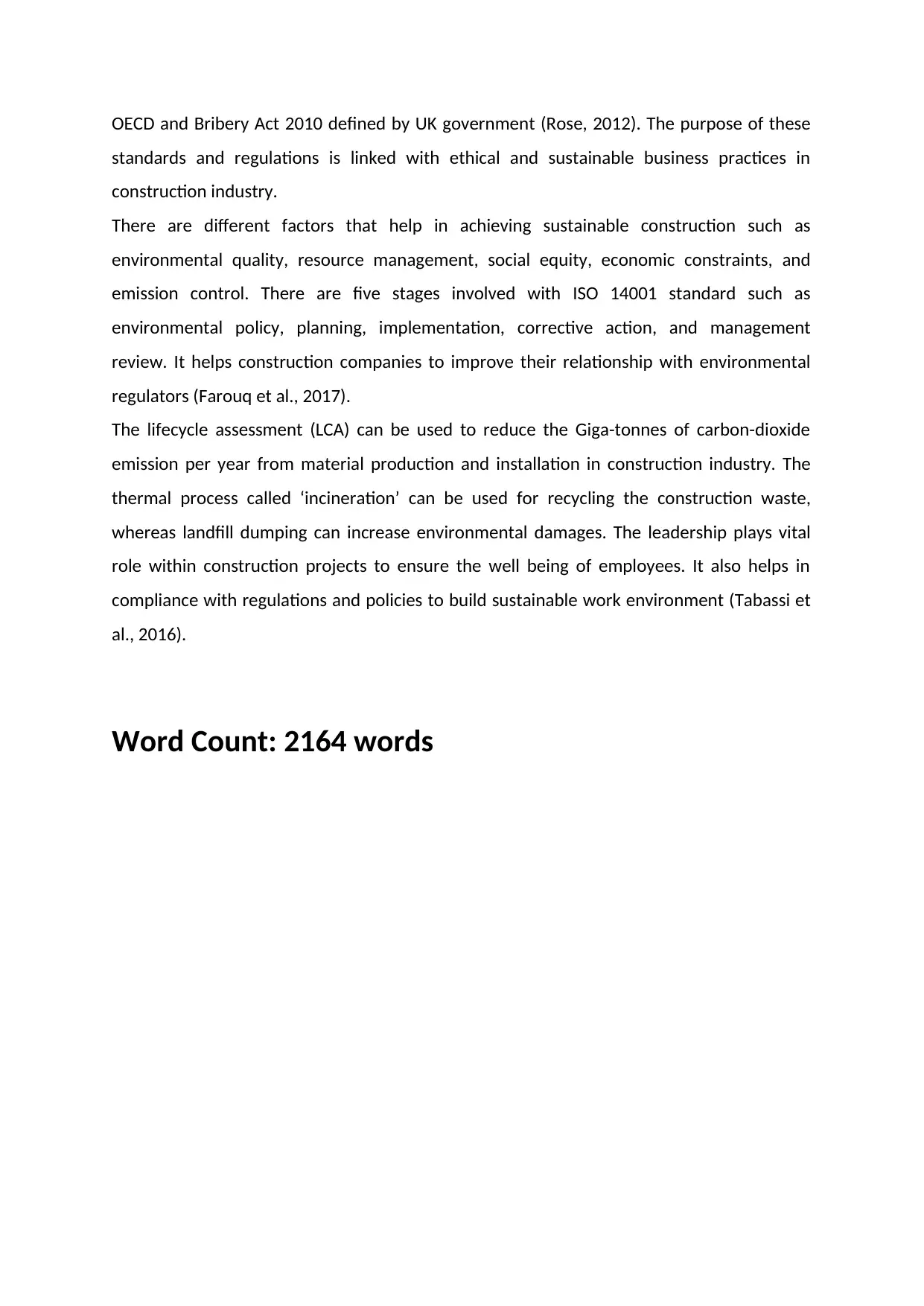
OECD and Bribery Act 2010 defined by UK government (Rose, 2012). The purpose of these
standards and regulations is linked with ethical and sustainable business practices in
construction industry.
There are different factors that help in achieving sustainable construction such as
environmental quality, resource management, social equity, economic constraints, and
emission control. There are five stages involved with ISO 14001 standard such as
environmental policy, planning, implementation, corrective action, and management
review. It helps construction companies to improve their relationship with environmental
regulators (Farouq et al., 2017).
The lifecycle assessment (LCA) can be used to reduce the Giga-tonnes of carbon-dioxide
emission per year from material production and installation in construction industry. The
thermal process called ‘incineration’ can be used for recycling the construction waste,
whereas landfill dumping can increase environmental damages. The leadership plays vital
role within construction projects to ensure the well being of employees. It also helps in
compliance with regulations and policies to build sustainable work environment (Tabassi et
al., 2016).
Word Count: 2164 words
standards and regulations is linked with ethical and sustainable business practices in
construction industry.
There are different factors that help in achieving sustainable construction such as
environmental quality, resource management, social equity, economic constraints, and
emission control. There are five stages involved with ISO 14001 standard such as
environmental policy, planning, implementation, corrective action, and management
review. It helps construction companies to improve their relationship with environmental
regulators (Farouq et al., 2017).
The lifecycle assessment (LCA) can be used to reduce the Giga-tonnes of carbon-dioxide
emission per year from material production and installation in construction industry. The
thermal process called ‘incineration’ can be used for recycling the construction waste,
whereas landfill dumping can increase environmental damages. The leadership plays vital
role within construction projects to ensure the well being of employees. It also helps in
compliance with regulations and policies to build sustainable work environment (Tabassi et
al., 2016).
Word Count: 2164 words
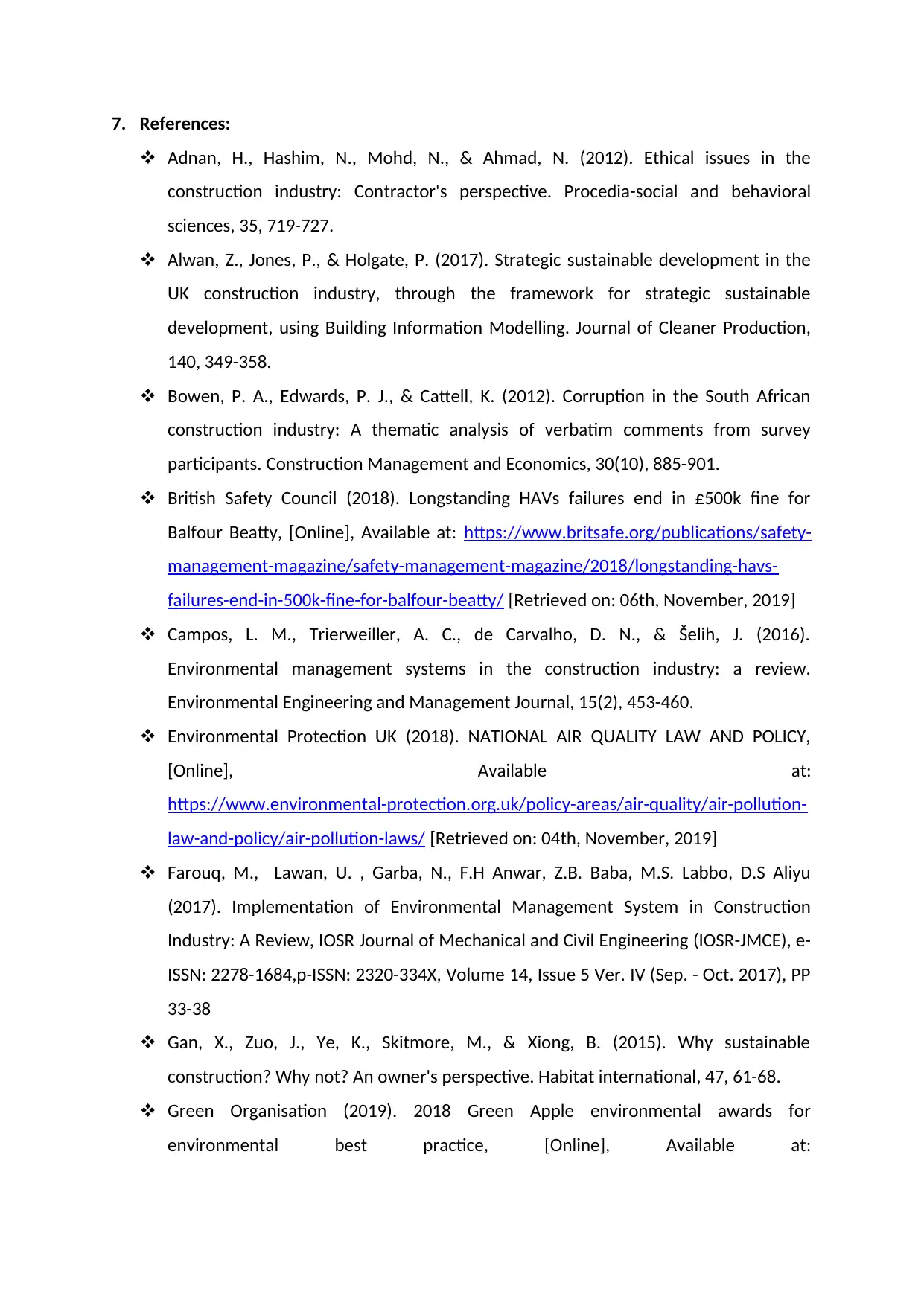
7. References:
Adnan, H., Hashim, N., Mohd, N., & Ahmad, N. (2012). Ethical issues in the
construction industry: Contractor's perspective. Procedia-social and behavioral
sciences, 35, 719-727.
Alwan, Z., Jones, P., & Holgate, P. (2017). Strategic sustainable development in the
UK construction industry, through the framework for strategic sustainable
development, using Building Information Modelling. Journal of Cleaner Production,
140, 349-358.
Bowen, P. A., Edwards, P. J., & Cattell, K. (2012). Corruption in the South African
construction industry: A thematic analysis of verbatim comments from survey
participants. Construction Management and Economics, 30(10), 885-901.
British Safety Council (2018). Longstanding HAVs failures end in £500k fine for
Balfour Beatty, [Online], Available at: https://www.britsafe.org/publications/safety-
management-magazine/safety-management-magazine/2018/longstanding-havs-
failures-end-in-500k-fine-for-balfour-beatty/ [Retrieved on: 06th, November, 2019]
Campos, L. M., Trierweiller, A. C., de Carvalho, D. N., & Šelih, J. (2016).
Environmental management systems in the construction industry: a review.
Environmental Engineering and Management Journal, 15(2), 453-460.
Environmental Protection UK (2018). NATIONAL AIR QUALITY LAW AND POLICY,
[Online], Available at:
https://www.environmental-protection.org.uk/policy-areas/air-quality/air-pollution-
law-and-policy/air-pollution-laws/ [Retrieved on: 04th, November, 2019]
Farouq, M., Lawan, U. , Garba, N., F.H Anwar, Z.B. Baba, M.S. Labbo, D.S Aliyu
(2017). Implementation of Environmental Management System in Construction
Industry: A Review, IOSR Journal of Mechanical and Civil Engineering (IOSR-JMCE), e-
ISSN: 2278-1684,p-ISSN: 2320-334X, Volume 14, Issue 5 Ver. IV (Sep. - Oct. 2017), PP
33-38
Gan, X., Zuo, J., Ye, K., Skitmore, M., & Xiong, B. (2015). Why sustainable
construction? Why not? An owner's perspective. Habitat international, 47, 61-68.
Green Organisation (2019). 2018 Green Apple environmental awards for
environmental best practice, [Online], Available at:
Adnan, H., Hashim, N., Mohd, N., & Ahmad, N. (2012). Ethical issues in the
construction industry: Contractor's perspective. Procedia-social and behavioral
sciences, 35, 719-727.
Alwan, Z., Jones, P., & Holgate, P. (2017). Strategic sustainable development in the
UK construction industry, through the framework for strategic sustainable
development, using Building Information Modelling. Journal of Cleaner Production,
140, 349-358.
Bowen, P. A., Edwards, P. J., & Cattell, K. (2012). Corruption in the South African
construction industry: A thematic analysis of verbatim comments from survey
participants. Construction Management and Economics, 30(10), 885-901.
British Safety Council (2018). Longstanding HAVs failures end in £500k fine for
Balfour Beatty, [Online], Available at: https://www.britsafe.org/publications/safety-
management-magazine/safety-management-magazine/2018/longstanding-havs-
failures-end-in-500k-fine-for-balfour-beatty/ [Retrieved on: 06th, November, 2019]
Campos, L. M., Trierweiller, A. C., de Carvalho, D. N., & Šelih, J. (2016).
Environmental management systems in the construction industry: a review.
Environmental Engineering and Management Journal, 15(2), 453-460.
Environmental Protection UK (2018). NATIONAL AIR QUALITY LAW AND POLICY,
[Online], Available at:
https://www.environmental-protection.org.uk/policy-areas/air-quality/air-pollution-
law-and-policy/air-pollution-laws/ [Retrieved on: 04th, November, 2019]
Farouq, M., Lawan, U. , Garba, N., F.H Anwar, Z.B. Baba, M.S. Labbo, D.S Aliyu
(2017). Implementation of Environmental Management System in Construction
Industry: A Review, IOSR Journal of Mechanical and Civil Engineering (IOSR-JMCE), e-
ISSN: 2278-1684,p-ISSN: 2320-334X, Volume 14, Issue 5 Ver. IV (Sep. - Oct. 2017), PP
33-38
Gan, X., Zuo, J., Ye, K., Skitmore, M., & Xiong, B. (2015). Why sustainable
construction? Why not? An owner's perspective. Habitat international, 47, 61-68.
Green Organisation (2019). 2018 Green Apple environmental awards for
environmental best practice, [Online], Available at:
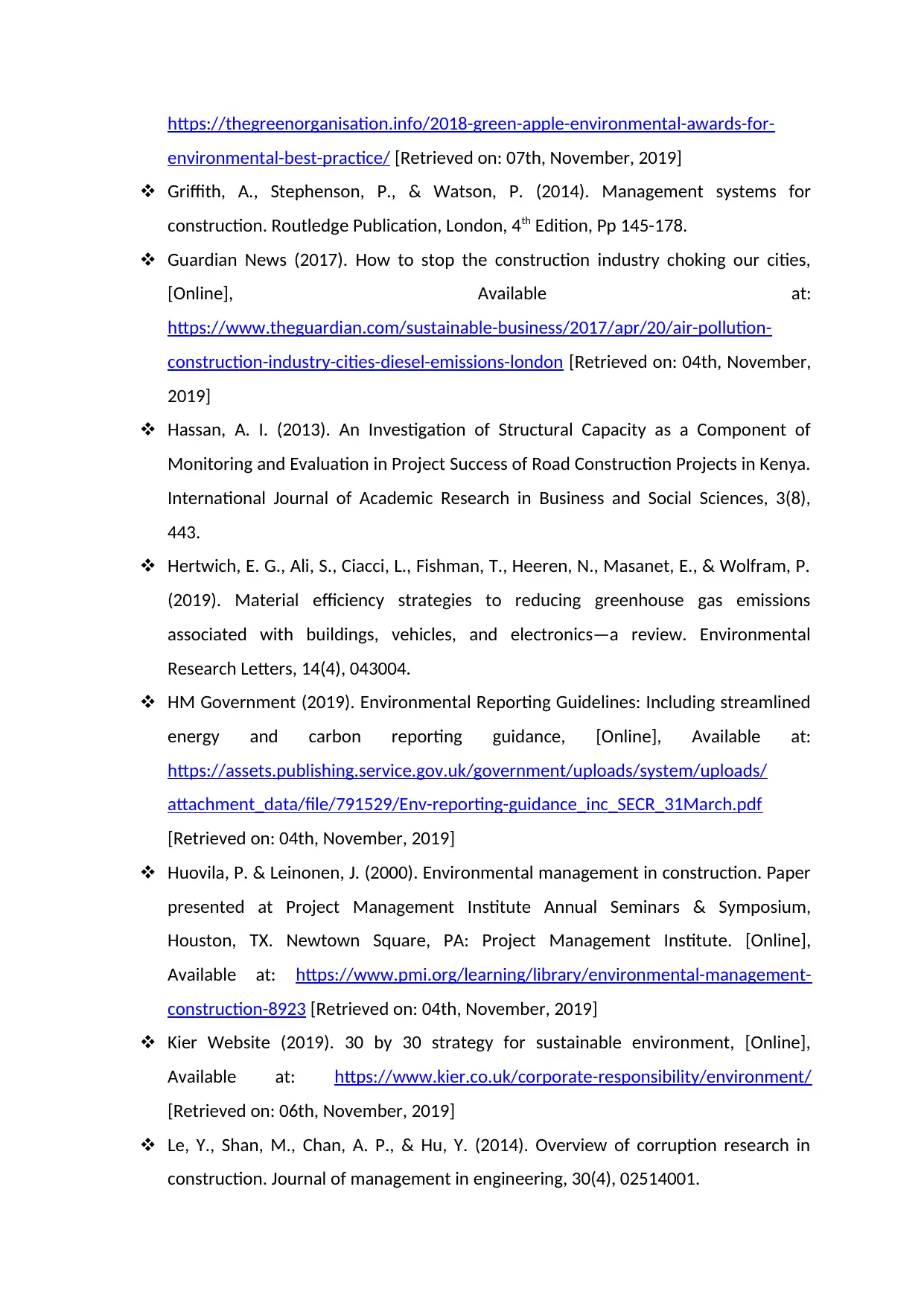
https://thegreenorganisation.info/2018-green-apple-environmental-awards-for-
environmental-best-practice/ [Retrieved on: 07th, November, 2019]
Griffith, A., Stephenson, P., & Watson, P. (2014). Management systems for
construction. Routledge Publication, London, 4th Edition, Pp 145-178.
Guardian News (2017). How to stop the construction industry choking our cities,
[Online], Available at:
https://www.theguardian.com/sustainable-business/2017/apr/20/air-pollution-
construction-industry-cities-diesel-emissions-london [Retrieved on: 04th, November,
2019]
Hassan, A. I. (2013). An Investigation of Structural Capacity as a Component of
Monitoring and Evaluation in Project Success of Road Construction Projects in Kenya.
International Journal of Academic Research in Business and Social Sciences, 3(8),
443.
Hertwich, E. G., Ali, S., Ciacci, L., Fishman, T., Heeren, N., Masanet, E., & Wolfram, P.
(2019). Material efficiency strategies to reducing greenhouse gas emissions
associated with buildings, vehicles, and electronics—a review. Environmental
Research Letters, 14(4), 043004.
HM Government (2019). Environmental Reporting Guidelines: Including streamlined
energy and carbon reporting guidance, [Online], Available at:
https://assets.publishing.service.gov.uk/government/uploads/system/uploads/
attachment_data/file/791529/Env-reporting-guidance_inc_SECR_31March.pdf
[Retrieved on: 04th, November, 2019]
Huovila, P. & Leinonen, J. (2000). Environmental management in construction. Paper
presented at Project Management Institute Annual Seminars & Symposium,
Houston, TX. Newtown Square, PA: Project Management Institute. [Online],
Available at: https://www.pmi.org/learning/library/environmental-management-
construction-8923 [Retrieved on: 04th, November, 2019]
Kier Website (2019). 30 by 30 strategy for sustainable environment, [Online],
Available at: https://www.kier.co.uk/corporate-responsibility/environment/
[Retrieved on: 06th, November, 2019]
Le, Y., Shan, M., Chan, A. P., & Hu, Y. (2014). Overview of corruption research in
construction. Journal of management in engineering, 30(4), 02514001.
environmental-best-practice/ [Retrieved on: 07th, November, 2019]
Griffith, A., Stephenson, P., & Watson, P. (2014). Management systems for
construction. Routledge Publication, London, 4th Edition, Pp 145-178.
Guardian News (2017). How to stop the construction industry choking our cities,
[Online], Available at:
https://www.theguardian.com/sustainable-business/2017/apr/20/air-pollution-
construction-industry-cities-diesel-emissions-london [Retrieved on: 04th, November,
2019]
Hassan, A. I. (2013). An Investigation of Structural Capacity as a Component of
Monitoring and Evaluation in Project Success of Road Construction Projects in Kenya.
International Journal of Academic Research in Business and Social Sciences, 3(8),
443.
Hertwich, E. G., Ali, S., Ciacci, L., Fishman, T., Heeren, N., Masanet, E., & Wolfram, P.
(2019). Material efficiency strategies to reducing greenhouse gas emissions
associated with buildings, vehicles, and electronics—a review. Environmental
Research Letters, 14(4), 043004.
HM Government (2019). Environmental Reporting Guidelines: Including streamlined
energy and carbon reporting guidance, [Online], Available at:
https://assets.publishing.service.gov.uk/government/uploads/system/uploads/
attachment_data/file/791529/Env-reporting-guidance_inc_SECR_31March.pdf
[Retrieved on: 04th, November, 2019]
Huovila, P. & Leinonen, J. (2000). Environmental management in construction. Paper
presented at Project Management Institute Annual Seminars & Symposium,
Houston, TX. Newtown Square, PA: Project Management Institute. [Online],
Available at: https://www.pmi.org/learning/library/environmental-management-
construction-8923 [Retrieved on: 04th, November, 2019]
Kier Website (2019). 30 by 30 strategy for sustainable environment, [Online],
Available at: https://www.kier.co.uk/corporate-responsibility/environment/
[Retrieved on: 06th, November, 2019]
Le, Y., Shan, M., Chan, A. P., & Hu, Y. (2014). Overview of corruption research in
construction. Journal of management in engineering, 30(4), 02514001.
Secure Best Marks with AI Grader
Need help grading? Try our AI Grader for instant feedback on your assignments.
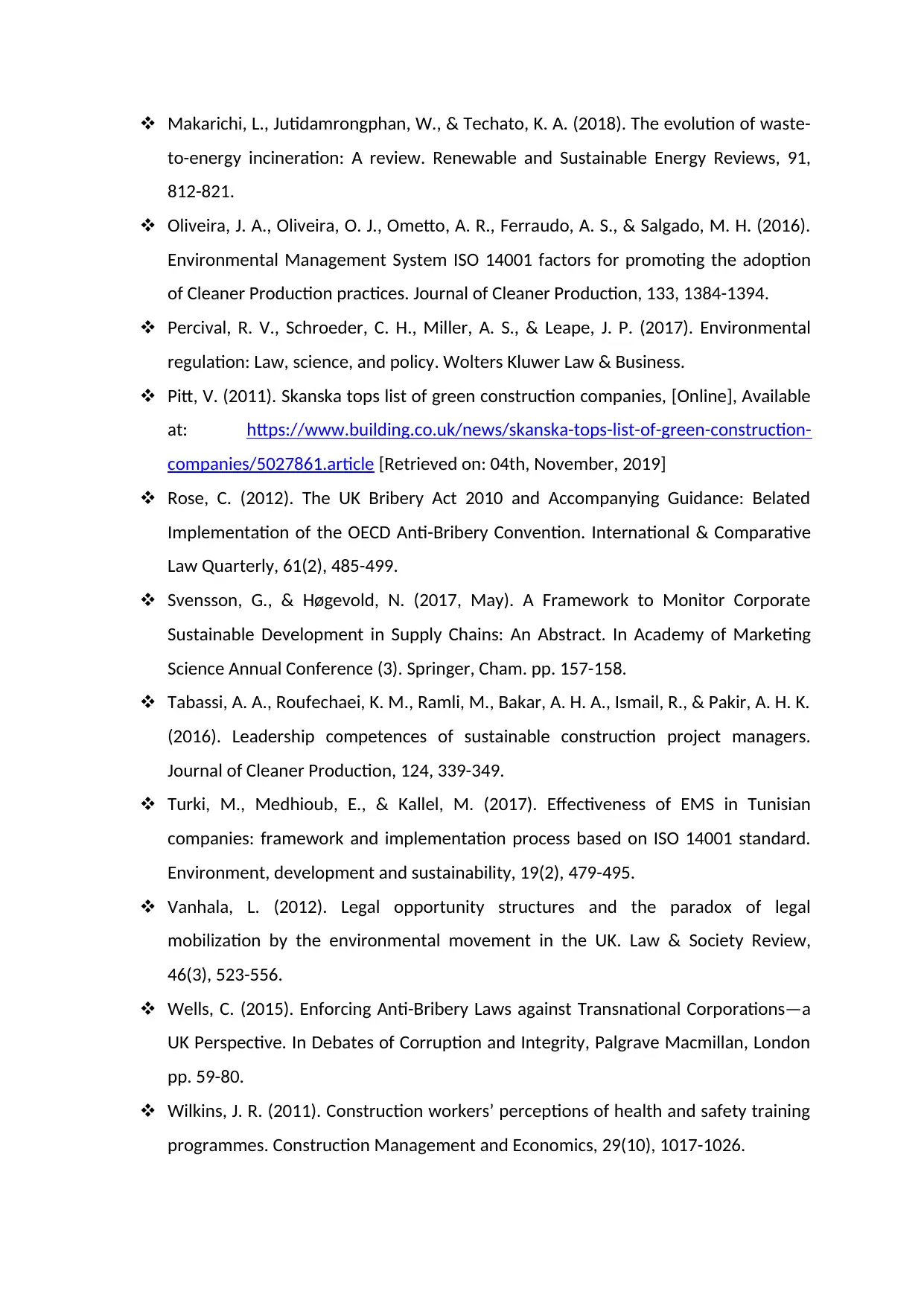
Makarichi, L., Jutidamrongphan, W., & Techato, K. A. (2018). The evolution of waste-
to-energy incineration: A review. Renewable and Sustainable Energy Reviews, 91,
812-821.
Oliveira, J. A., Oliveira, O. J., Ometto, A. R., Ferraudo, A. S., & Salgado, M. H. (2016).
Environmental Management System ISO 14001 factors for promoting the adoption
of Cleaner Production practices. Journal of Cleaner Production, 133, 1384-1394.
Percival, R. V., Schroeder, C. H., Miller, A. S., & Leape, J. P. (2017). Environmental
regulation: Law, science, and policy. Wolters Kluwer Law & Business.
Pitt, V. (2011). Skanska tops list of green construction companies, [Online], Available
at: https://www.building.co.uk/news/skanska-tops-list-of-green-construction-
companies/5027861.article [Retrieved on: 04th, November, 2019]
Rose, C. (2012). The UK Bribery Act 2010 and Accompanying Guidance: Belated
Implementation of the OECD Anti-Bribery Convention. International & Comparative
Law Quarterly, 61(2), 485-499.
Svensson, G., & Høgevold, N. (2017, May). A Framework to Monitor Corporate
Sustainable Development in Supply Chains: An Abstract. In Academy of Marketing
Science Annual Conference (3). Springer, Cham. pp. 157-158.
Tabassi, A. A., Roufechaei, K. M., Ramli, M., Bakar, A. H. A., Ismail, R., & Pakir, A. H. K.
(2016). Leadership competences of sustainable construction project managers.
Journal of Cleaner Production, 124, 339-349.
Turki, M., Medhioub, E., & Kallel, M. (2017). Effectiveness of EMS in Tunisian
companies: framework and implementation process based on ISO 14001 standard.
Environment, development and sustainability, 19(2), 479-495.
Vanhala, L. (2012). Legal opportunity structures and the paradox of legal
mobilization by the environmental movement in the UK. Law & Society Review,
46(3), 523-556.
Wells, C. (2015). Enforcing Anti-Bribery Laws against Transnational Corporations—a
UK Perspective. In Debates of Corruption and Integrity, Palgrave Macmillan, London
pp. 59-80.
Wilkins, J. R. (2011). Construction workers’ perceptions of health and safety training
programmes. Construction Management and Economics, 29(10), 1017-1026.
to-energy incineration: A review. Renewable and Sustainable Energy Reviews, 91,
812-821.
Oliveira, J. A., Oliveira, O. J., Ometto, A. R., Ferraudo, A. S., & Salgado, M. H. (2016).
Environmental Management System ISO 14001 factors for promoting the adoption
of Cleaner Production practices. Journal of Cleaner Production, 133, 1384-1394.
Percival, R. V., Schroeder, C. H., Miller, A. S., & Leape, J. P. (2017). Environmental
regulation: Law, science, and policy. Wolters Kluwer Law & Business.
Pitt, V. (2011). Skanska tops list of green construction companies, [Online], Available
at: https://www.building.co.uk/news/skanska-tops-list-of-green-construction-
companies/5027861.article [Retrieved on: 04th, November, 2019]
Rose, C. (2012). The UK Bribery Act 2010 and Accompanying Guidance: Belated
Implementation of the OECD Anti-Bribery Convention. International & Comparative
Law Quarterly, 61(2), 485-499.
Svensson, G., & Høgevold, N. (2017, May). A Framework to Monitor Corporate
Sustainable Development in Supply Chains: An Abstract. In Academy of Marketing
Science Annual Conference (3). Springer, Cham. pp. 157-158.
Tabassi, A. A., Roufechaei, K. M., Ramli, M., Bakar, A. H. A., Ismail, R., & Pakir, A. H. K.
(2016). Leadership competences of sustainable construction project managers.
Journal of Cleaner Production, 124, 339-349.
Turki, M., Medhioub, E., & Kallel, M. (2017). Effectiveness of EMS in Tunisian
companies: framework and implementation process based on ISO 14001 standard.
Environment, development and sustainability, 19(2), 479-495.
Vanhala, L. (2012). Legal opportunity structures and the paradox of legal
mobilization by the environmental movement in the UK. Law & Society Review,
46(3), 523-556.
Wells, C. (2015). Enforcing Anti-Bribery Laws against Transnational Corporations—a
UK Perspective. In Debates of Corruption and Integrity, Palgrave Macmillan, London
pp. 59-80.
Wilkins, J. R. (2011). Construction workers’ perceptions of health and safety training
programmes. Construction Management and Economics, 29(10), 1017-1026.
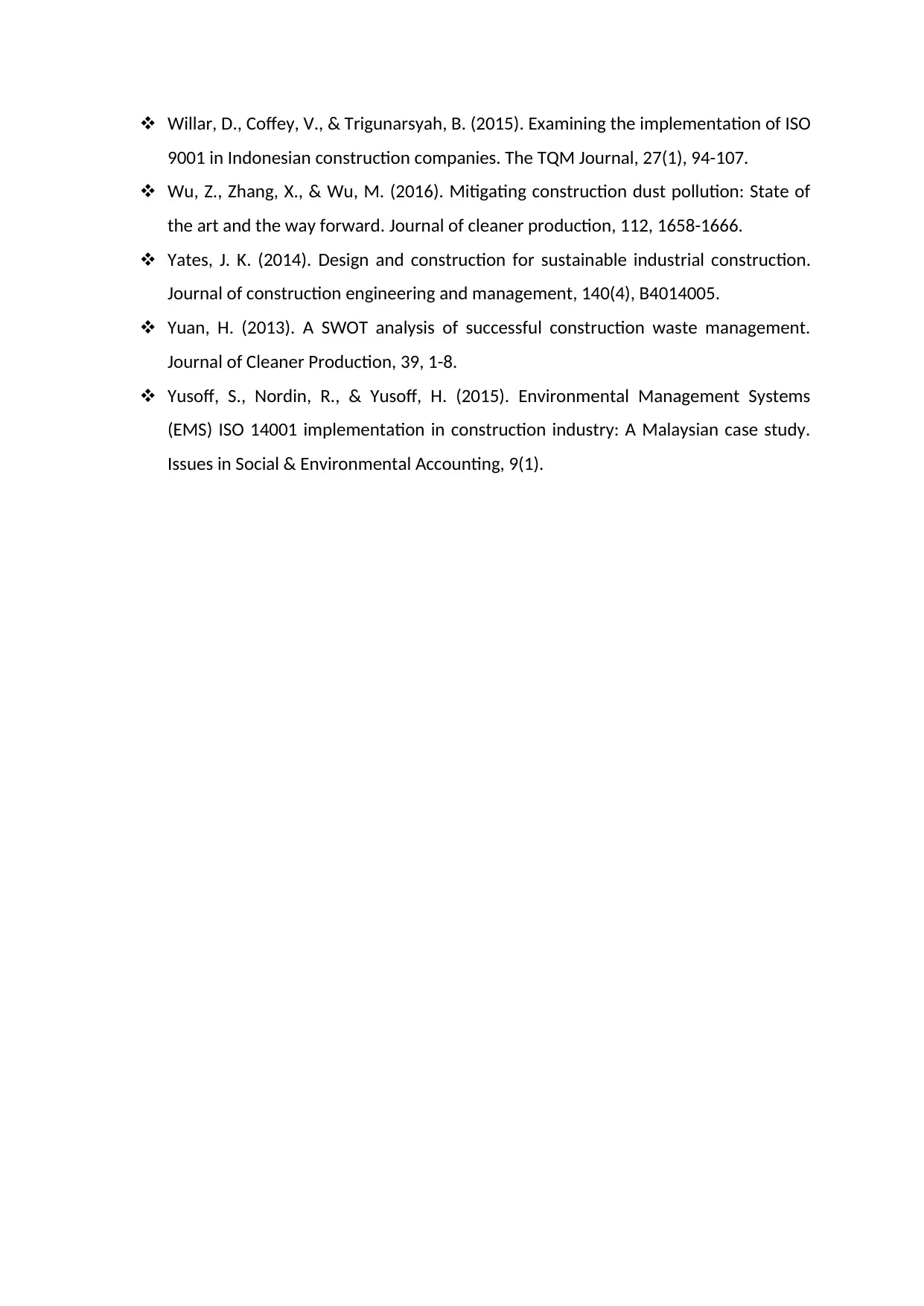
Willar, D., Coffey, V., & Trigunarsyah, B. (2015). Examining the implementation of ISO
9001 in Indonesian construction companies. The TQM Journal, 27(1), 94-107.
Wu, Z., Zhang, X., & Wu, M. (2016). Mitigating construction dust pollution: State of
the art and the way forward. Journal of cleaner production, 112, 1658-1666.
Yates, J. K. (2014). Design and construction for sustainable industrial construction.
Journal of construction engineering and management, 140(4), B4014005.
Yuan, H. (2013). A SWOT analysis of successful construction waste management.
Journal of Cleaner Production, 39, 1-8.
Yusoff, S., Nordin, R., & Yusoff, H. (2015). Environmental Management Systems
(EMS) ISO 14001 implementation in construction industry: A Malaysian case study.
Issues in Social & Environmental Accounting, 9(1).
9001 in Indonesian construction companies. The TQM Journal, 27(1), 94-107.
Wu, Z., Zhang, X., & Wu, M. (2016). Mitigating construction dust pollution: State of
the art and the way forward. Journal of cleaner production, 112, 1658-1666.
Yates, J. K. (2014). Design and construction for sustainable industrial construction.
Journal of construction engineering and management, 140(4), B4014005.
Yuan, H. (2013). A SWOT analysis of successful construction waste management.
Journal of Cleaner Production, 39, 1-8.
Yusoff, S., Nordin, R., & Yusoff, H. (2015). Environmental Management Systems
(EMS) ISO 14001 implementation in construction industry: A Malaysian case study.
Issues in Social & Environmental Accounting, 9(1).
1 out of 12
Related Documents
Your All-in-One AI-Powered Toolkit for Academic Success.
+13062052269
info@desklib.com
Available 24*7 on WhatsApp / Email
![[object Object]](/_next/static/media/star-bottom.7253800d.svg)
Unlock your academic potential
© 2024 | Zucol Services PVT LTD | All rights reserved.




